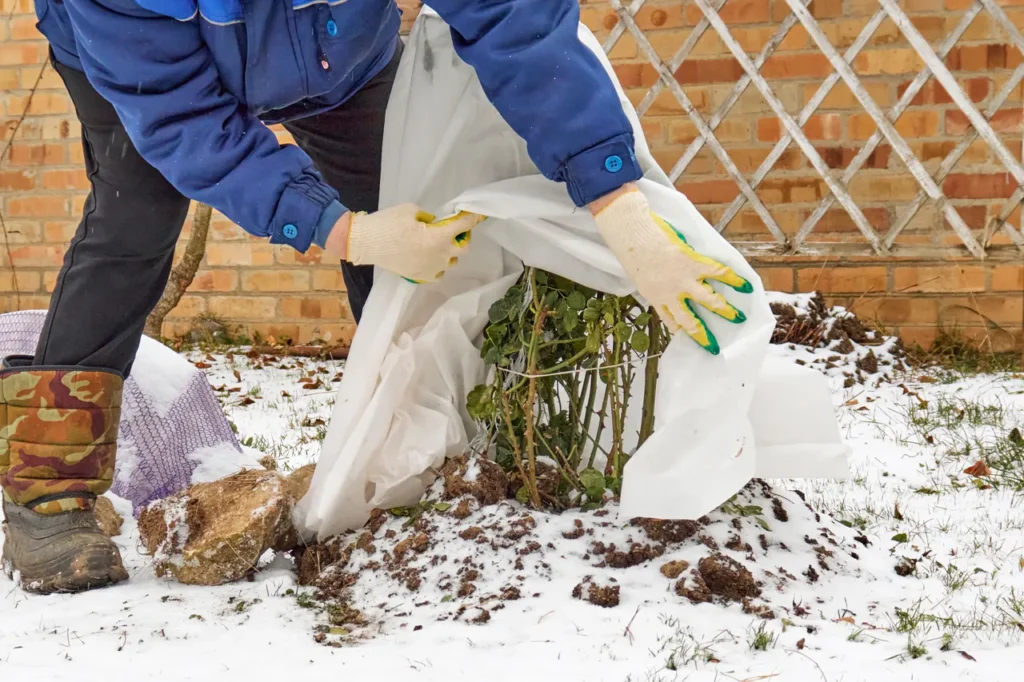We’re letting you know that this post contains sponsored links which Your Savvy Purse receives compensation for, which may impact their order of appearance.
As the temperatures dip and winter approaches, frost can become a major threat to your garden. While some plants can tolerate a light frost, others are more vulnerable and can suffer significant damage from freezing temperatures. Whether you’re a seasoned gardener or a newcomer, knowing how to protect your plants from frost is essential for keeping your garden healthy throughout the colder months.
In this post, we’ll walk you through practical ways to shield your plants from frost, ensuring they survive and thrive until the warmth of spring returns.
1. Know Your Frost Dates
The first step in protecting your plants from frost is knowing when the first frost is likely to occur in your area. Frost dates vary depending on your region, so check your local gardening resources, weather reports, or online tools like the USDA Plant Hardiness Zone Map to determine the approximate dates. Marking these dates on your calendar will give you a heads-up on when to start taking protective measures.
2. Choose Frost-Tolerant Plants
If you live in an area with long, cold winters, consider selecting plants that are naturally frost-tolerant. Many vegetables, flowers, and shrubs are hardy to a certain temperature range. For example, kale, spinach, and other leafy greens can withstand light frost, while more delicate plants like tomatoes, peppers, and basil are highly sensitive to freezing temperatures.
By planting frost-tolerant varieties, you reduce the need for heavy frost protection, though it’s still important to monitor the weather and act when necessary.
3. Bring Potted Plants Indoors
If you have plants in containers, it’s easy to protect them from frost by moving them indoors or into a sheltered space like a garage, porch, or greenhouse. Even a few days of cold weather can damage sensitive potted plants, so try to move them before frost arrives. If moving them indoors isn’t an option, try to group pots together against a wall, as this provides some natural insulation.
4. Cover Your Plants with Frost Cloth or Blankets
One of the simplest and most effective ways to protect plants from frost is by covering them with frost cloth, blankets, or old sheets. These materials trap heat from the soil and create a protective barrier around your plants. You can use stakes or a frame to keep the covering off the plant, allowing it to breathe and preventing the cloth from touching the foliage, which can sometimes cause frost damage.
Make sure to remove covers during the day if temperatures rise above freezing, so the plants can get sunlight and fresh air. If the frost is expected to last for an extended period, make sure the covering is secure and won’t blow away.
Tip: Avoid using plastic to cover plants, as it can trap moisture, leading to mold or mildew growth and possibly causing more harm than good.
5. Use Mulch to Insulate the Soil
Mulch is a gardener’s best friend when it comes to protecting plants from frost. A thick layer of mulch (about 3–4 inches) around the base of plants acts as an insulator, preventing the soil from freezing and protecting roots from temperature fluctuations. Mulch also helps retain moisture in the soil and reduces the likelihood of plants being damaged by the cold.
Use materials like straw, shredded leaves, wood chips, or grass clippings. For vegetable gardens, adding a layer of mulch before the first frost helps keep the soil temperature stable, which is crucial for root health.
6. Create Temporary Greenhouses or Cold Frames
For more permanent protection, you can create a small greenhouse or cold frame around tender plants. Cold frames are small structures, usually made of clear plastic or glass, that allow sunlight to pass through while trapping heat and insulating plants against frost. They can be as simple as an old window frame propped up on bricks or a more elaborate structure.
These DIY mini greenhouses are great for protecting plants like tomatoes, peppers, and other vegetables that may not be winter hardy in your area.
7. Water Plants Before a Frost Event
This might seem counterintuitive, but watering your plants before a frost can actually help protect them. Moist soil holds more heat than dry soil, so watering thoroughly the day before a frost event can help keep the root zone warm, which in turn helps keep the plants from freezing. Just be sure to water early in the day so that the water has time to soak into the soil before temperatures drop overnight.
8. Use Row Covers for Larger Gardens
For gardeners with larger vegetable plots, row covers are an excellent way to protect rows of plants from frost. These are lightweight, breathable fabric sheets that you can drape over plants or crops to shield them from frost while still allowing sunlight and moisture to reach the plants. Row covers are often used in vegetable gardens to extend the growing season, especially for cold-weather crops like spinach, lettuce, and carrots.
For extra protection, row covers can be combined with hoops or frames to keep the material off the plants, creating a mini greenhouse effect.
9. Provide Wind Protection
Cold, windy conditions can increase the risk of frost damage by lowering the temperature around your plants and causing rapid heat loss. If you live in an area with cold winter winds, try to shield your plants by placing them near walls, fences, or structures that can block the wind. You can also use windbreaks, like burlap or shade cloth, to reduce wind exposure.
Windbreaks not only protect against frost, but they can also prevent desiccation (drying out) from harsh winds.
10. Bring Sensitive Houseplants Inside
If you have plants that can’t tolerate frost, such as tropical houseplants or delicate herbs, it’s best to bring them indoors before the first frost hits. Be sure to check them for pests before moving them inside to avoid introducing unwanted critters into your home. If you don’t have space indoors, consider placing them in a bright window or a heated sunroom, where they’ll continue to thrive.
Conclusion
Protecting your plants from frost doesn’t have to be a daunting task. With the right planning and care, you can shield your plants from freezing temperatures and help them survive the winter. By using frost covers, mulching, watering strategically, and selecting frost-tolerant varieties, you can give your garden the best chance at staying healthy through the colder months.
Remember, the key to protecting plants from frost is being proactive. Pay attention to weather forecasts, monitor your plants regularly, and take action when frost is expected. A little extra effort now can ensure your garden blooms again in the spring!
Happy gardening—and may your plants stay safe and warm this winter!



